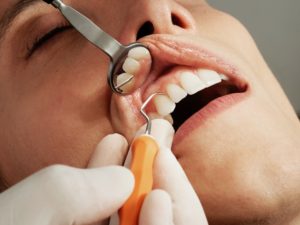You Have Gum Disease: Now What?


Gum disease occurs when bacteria builds up in plaque and tartar, infecting your gums. Dealing with that diagnosis depends on the type of gum disease you have.
While no one likes to hear that they have a problem, early diagnosis can stop gum disease from spreading and causing further damage to your teeth and bones.
Diagnosis
The earliest and most crucial step when dealing with gum disease is diagnosing the problem. If you notice bleeding gums or swelling around the base of your teeth, seek professional help immediately. Healthy gums should be pink and firm, and they shouldn’t bleed when you brush or floss.
There are two types of gum disease: gingivitis and periodontitis. Gingivitis is the earliest form and the only form that is reversible. With gingivitis, your gums become inflamed and red.
Periodontitis is more severe and occurs when the infection spreads below the gum line. From there, the bacteria can infect the ligaments holding your teeth in place or even your jawbone. Signs of periodontitis include the swollen, red gums typical of gingivitis, but now they may also bleed, and in more severe cases, your teeth become loose.
Curing Gingivitis
Gingivitis is the early form of gum disease and the good news is that it is reversible. The best thing to do is prevent gingivitis with good dental care, such as daily brushing and flossing. It’s also important to get regular deep cleanings by a dental hygienist. It may take time, but with good dental hygiene, you and your dentist can cure gingivitis entirely.
Once you cure the disease, you will need to keep gingivitis from returning. The best way to prevent gingivitis is to continue your good oral hygiene regimen and book regular visits to your dentist.
Treating Periodontitis
Once the gum disease infection reaches below the gum line, a complete cure is not possible. However, treatment can ensure that the disease doesn’t progress.
In addition to a thorough cleaning, your dentist may need to clean the tooth surface far below the gumline. One such treatment is minor surgery. Your dentist will make small incisions in the gum and flip it away from the tooth.
After smoothing the root surface, your dentist will stitch the gums together to keep the gum sealed around the tooth. They will also give you a dose of antibiotics to stop swelling and pain.
Like gingivitis, periodontitis needs regular follow up and care. Once you receive the diagnosis, you will work with your dentist to schedule checkups to ensure that your gum disease is under control.
Final Thoughts
In the Dallas, TX area, Dr. Brad Crump and his professional staff can help you maintain a healthy, beautiful smile. Just give our office a call today for a consultation appointment!